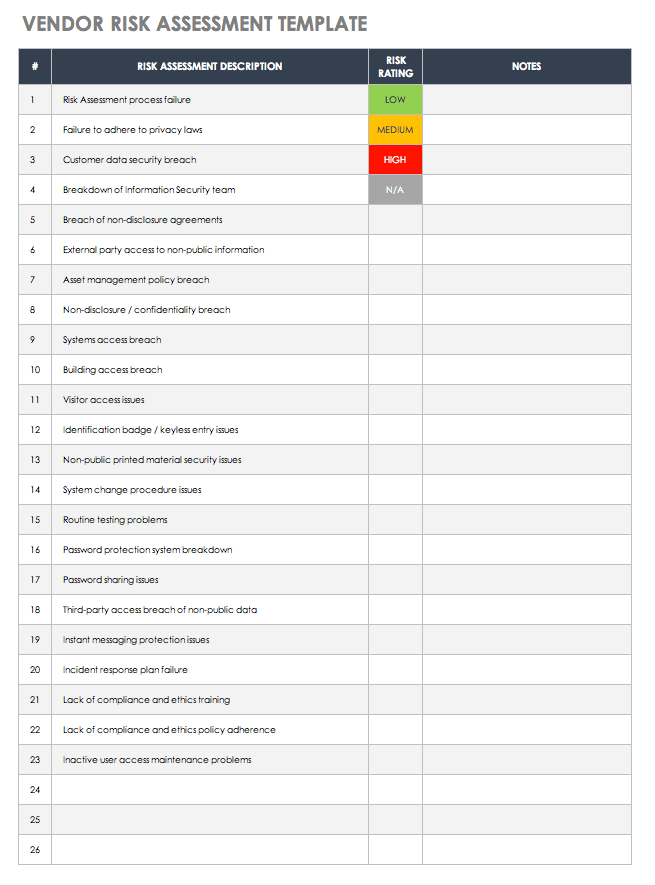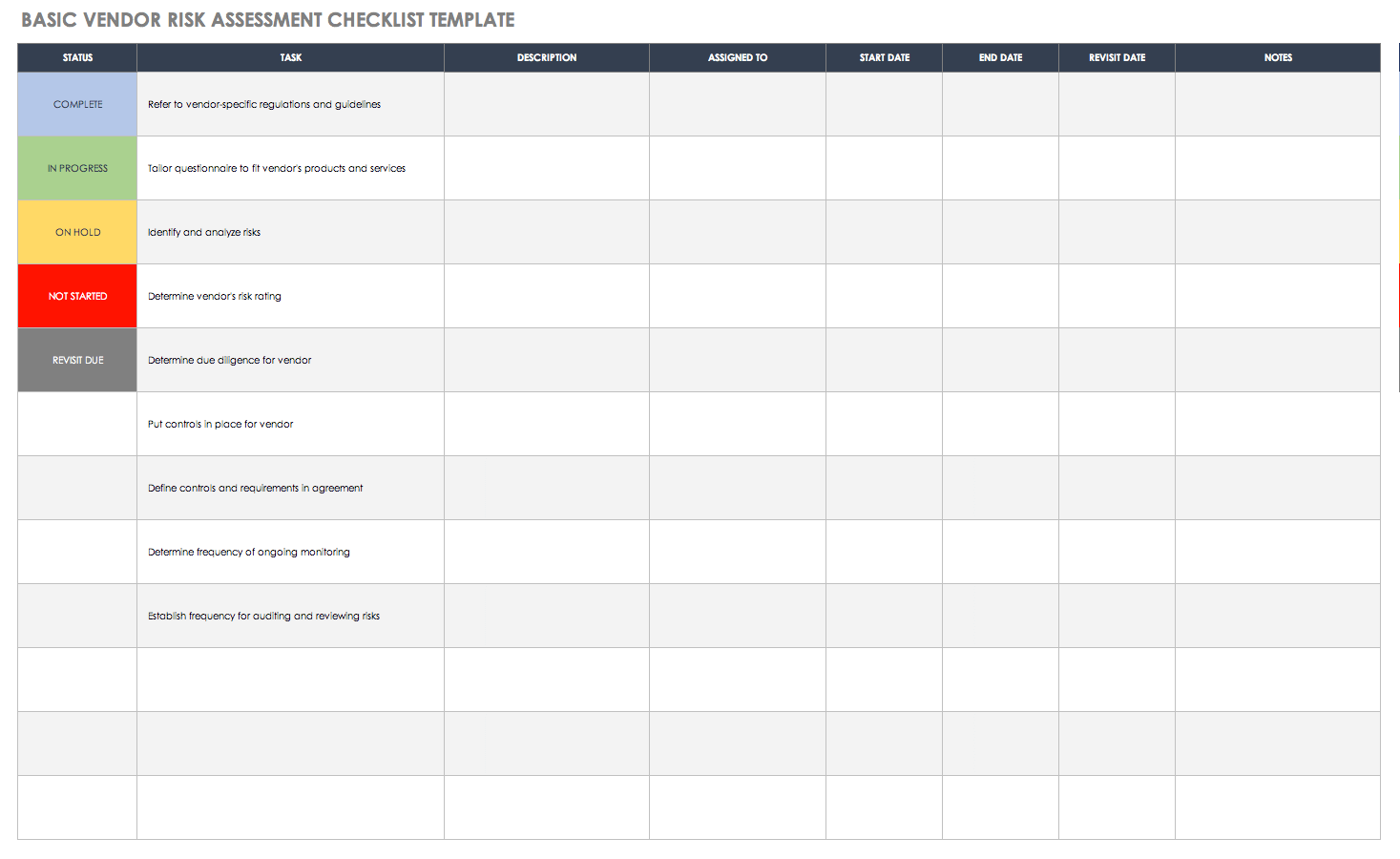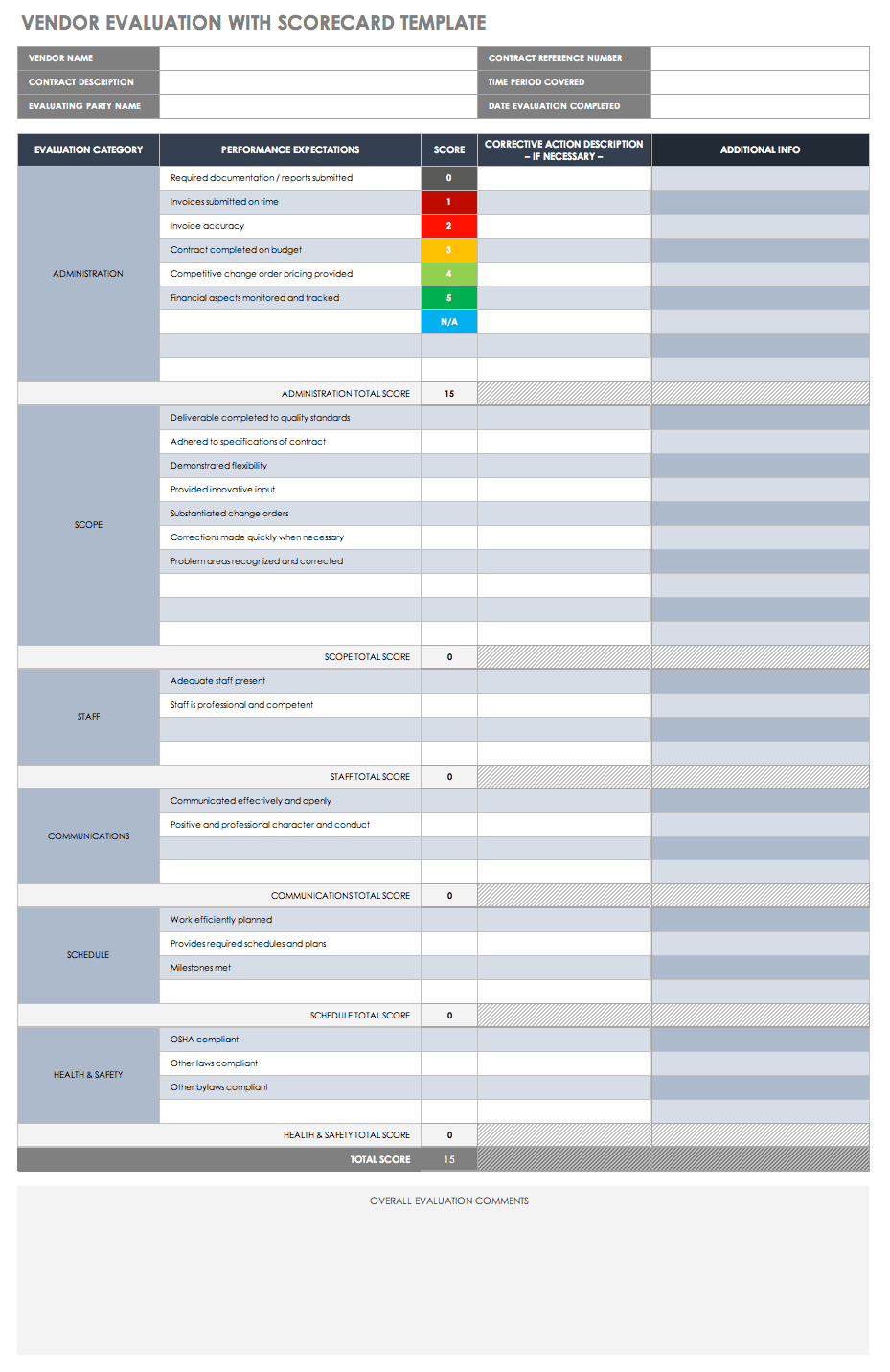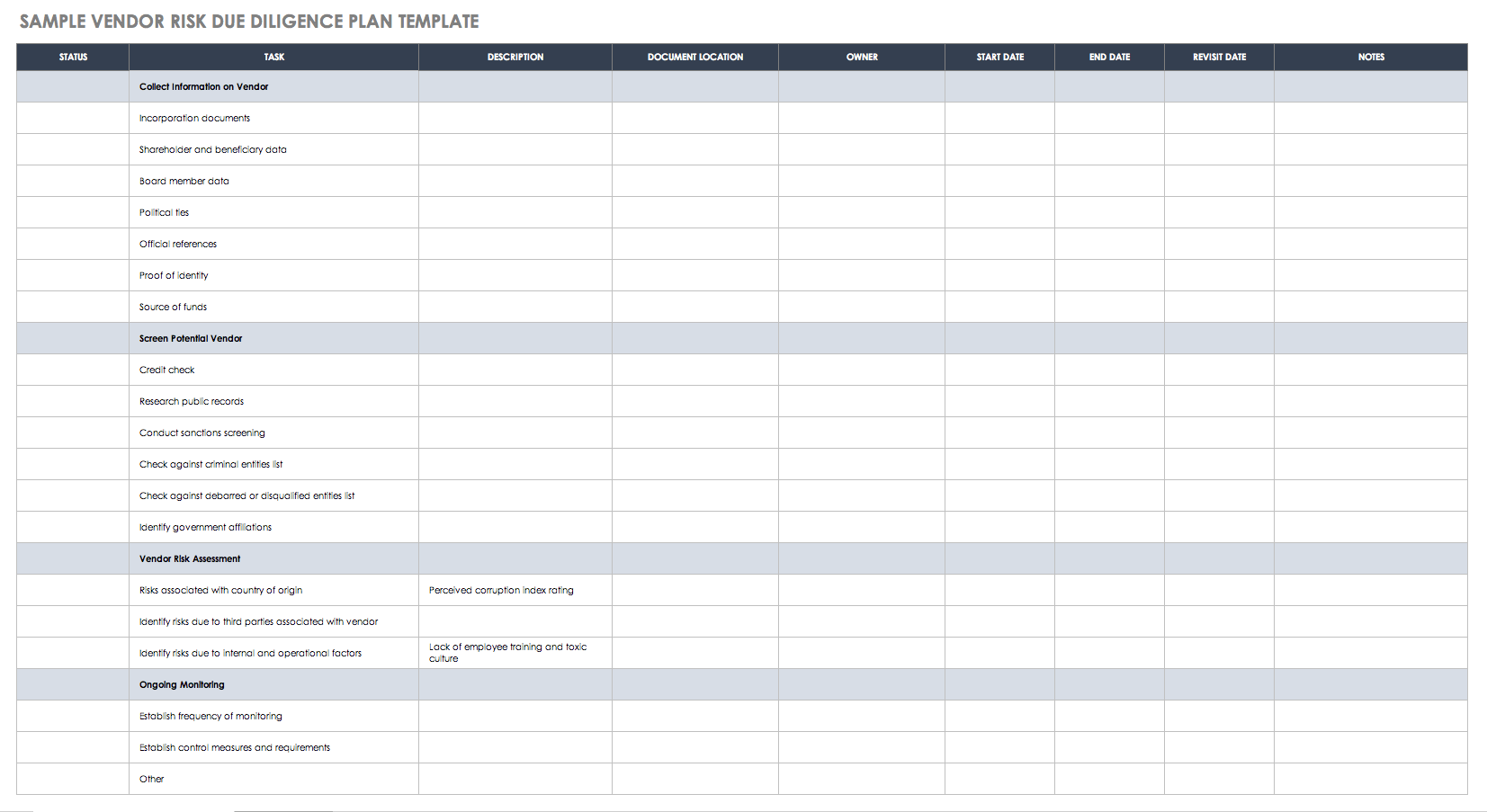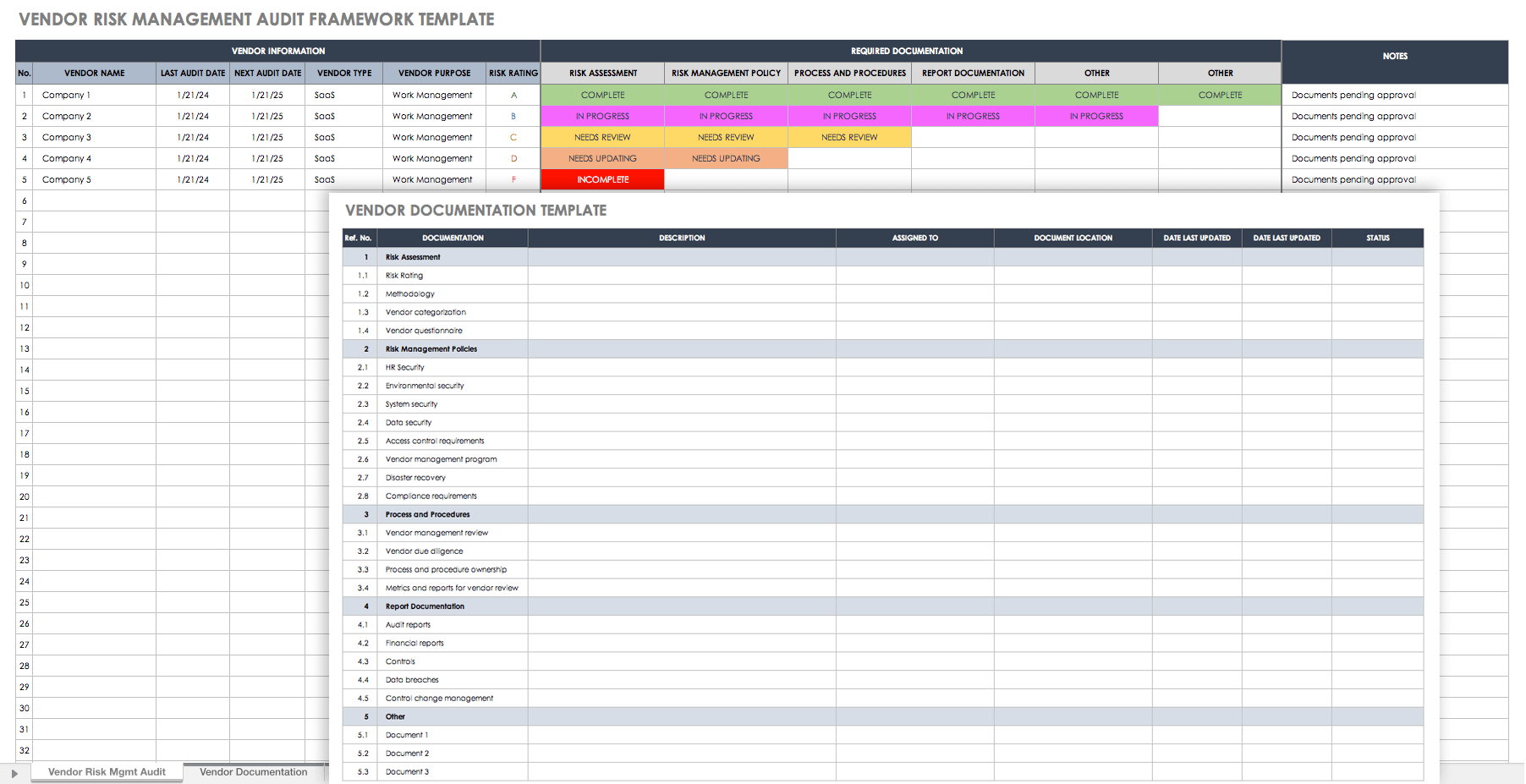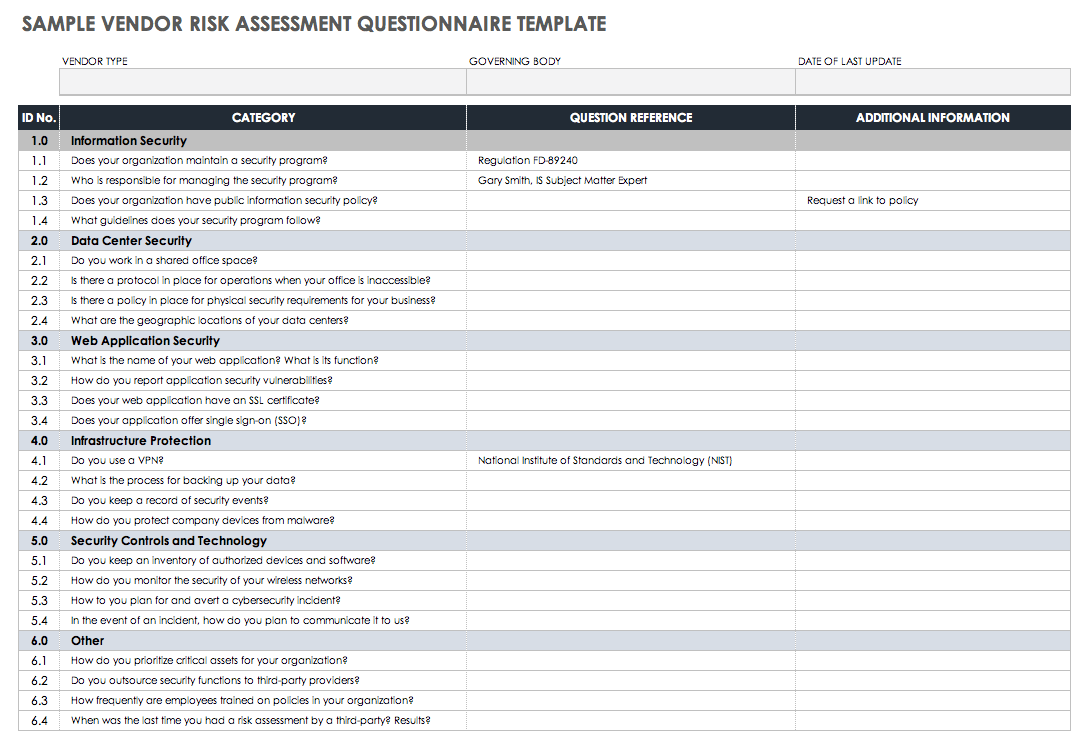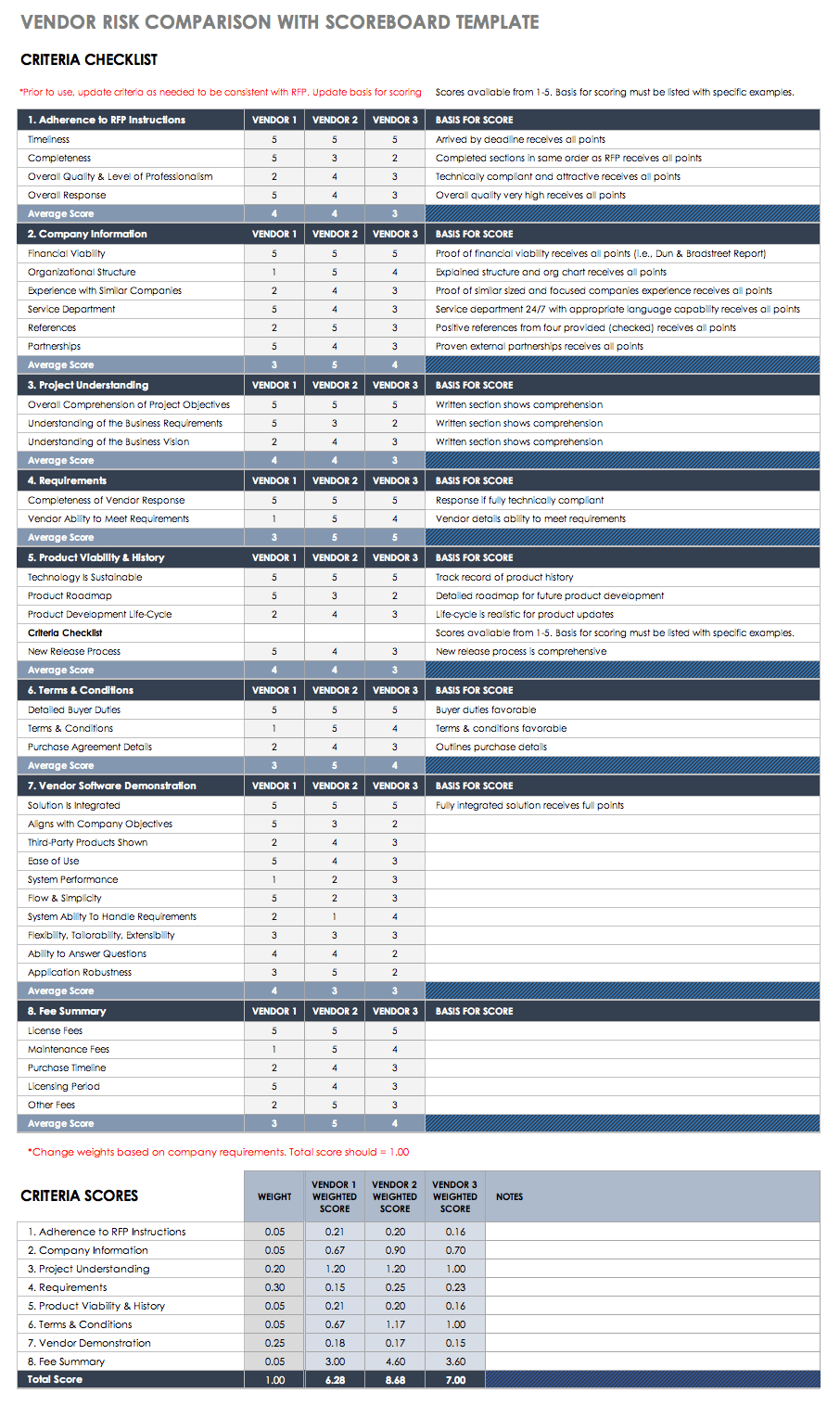Vendor Risk Assessment Template
Also known as a third-party risk assessment, this template allows you to list assessment descriptions to identify the vulnerabilities associated with a specific vendor. Use the color-coded risk rating key to assign a rating to each risk description, and add notes in the space provided. Use this template to analyze each vendor, and tailor the risk assessment descriptions to fit your needs.
Download Vendor Risk Assessment Template
Basic Vendor Risk Assessment Checklist
Use this basic vendor risk assessment checklist template to outline the steps your team needs to take in the risk assessment process. For each task, list a description, owner, due date(s), date(s) to revisit it, and any pertinent notes. With this checklist, you can streamline your process for each vendor and ensure you don’t miss any crucial steps along the way.
Download Basic Vendor Risk Assessment Checklist
Vendor Risk Evaluation with Scorecard Template
You can use this vendor evaluation with scorecard template to assess the performance of a vendor after a specified period of time. This template is organized into categories, including administration, scope, staff, communication, health and safety, and schedule. There is also space to include information (such as corrective actions) that helps mitigate the risks you’ve identified. You can customize the evaluation categories, performance expectations, and color-coded score key to fit your needs.
Download Vendor Risk Evaluation with Scorecard Template
Sample Vendor Risk Due Diligence Plan Template
This vendor risk due diligence plan template provides a sample of steps to take in a due diligence process. This template organizes tasks into categories, with subtasks listed below each category; you can tailor these subtasks to fit the needs of your organization. There is also space to include task descriptions, the documentation location, task ownership, key dates, notes, and the status of each task.
Download Sample Vendor Risk Due Diligence Plan Template
Excel | PDF | Smartsheet
Vendor Risk Management Audit Framework Template
Use this vendor risk management audit framework template to track audit information, as well as the status of the documentation you need for each vendor. List each third party your organization conducts business with. Then, input audit dates, vendor types, risk ratings, and the status of documentation to access all this information at a high-level view. There is an additional tab in this template that allows you to track the documentation status of an individual vendor at a granular level, including the status of documents you need for risk assessments, risk management policies, report documentation, and process and procedures. You can also use this template to support your company’s vendor due diligence process.
Download Vendor Risk Management Audit Framework Template
Sample Vendor Risk Assessment Questionnaire Template
Use this sample vendor risk assessment questionnaire template to build a questionnaire specific to the vendor type and in accordance with the guidelines that the appropriate governing body requires. This template contains sample questions in various categories and includes space to provide the point of reference for each question (e.g., internal subject matter experts [SMEs], industry standard assessment procedures, etc.). When assessing third-party suppliers, use this template as a master list to extract questions that are relevant to a particular vendor and in lockstep with the needs of your organization.
Download Sample Vendor Risk Assessment Questionnaire Template - Excel
Vendor Risk Comparison with Scorecard Template
Use this vendor risk comparison with scorecard template to compare each vendor's weighted score during the vetting process. Collect and compile data in this template, score each vendor according to your established scoring system, and then compare how vendors rank against the various criteria that are important to your business.
Download Vendor Risk Comparison with Scorecard Template - Excel
For additional resources to help support your vendor relationship and management program, check out these 13 free vendor templates.
How Do You Perform a Vendor Risk Assessment?
A vendor risk assessment is a vital part of a holistic vendor management program. This assessment can take place during the vetting phase, or during an evaluation or review in order to measure performance on a continual basis.
Below, you’ll find some best practices to help you prepare for a thorough risk assessment.
Best Practices to Prepare for and Conduct a Thorough Risk Assessment
Follow the best practices below to conduct a thorough risk assessment:
- Have a clear understanding of your business objectives and risk tolerance prior to the vetting phase.
- During the vetting process, check for vendor reliability using a variety of methods, including background checks, customer reviews, and references from credible sources.
- Create a list of all current vendors and organize the list by category (e.g., healthcare, payment processors, office services, etc.).
- Check your vendor list against the list that your accounting department maintains to ensure that all vendors are accounted for.
- Determine which vendors have the greatest impact on your business (for example, do you consider a third party critical or non-critical?).
- Assign each vendor a risk rating (from moderate to critical) according to the vendor’s potential to pose regulatory compliance challenges, data security concerns, or financial risk to your organization.
- Establish the required, ongoing due diligence you must perform on each vendor based on its level of risk. Focus the most on high-impact vendors that pose a medium-to-high risk to your company.
- Gather information from internal subject matter experts, and stay current on changing regulations and guidelines, so you can update questionnaires and risk assessments accordingly.
- Standardize your vendor management program to keep processes streamlined and efficient.
- Conduct due diligence reviews and measure the effectiveness of your vendor management program on a continual basis.
Why Is a Vendor Risk Assessment Important?
When your business understands and effectively manages third-party risks with a sound vendor management program, you can pinpoint vendors that are critical to business operations and proactively mitigate undue risks. Conducting an adequate risk assessment is a critical element of the vendor management process.
For more information, including expert advice on vendor due diligence and monitoring, visit "Simplified Guide to Vendor Risk Assessment."
Key Benefits of a Vendor Risk Assessment
A vendor risk assessment can offer your company tremendous advantages. Here are the key benefits of the process:
- Identify Third-Party Vulnerabilities: A thorough review of a vendor helps you identify any potential weaknesses that could pose a security threat to your business. Determine the significance of any vulnerabilities based on the impact a vendor has on your business. You can ascertain a vendor’s impact by considering the following questions: What types of information will the vendor have access to? How critical is the vendor to business operations?
- Mitigate Risk: Identifying vulnerabilities — especially during the vetting process — enables you to decide how you want to move forward with a particular vendor (e.g., accept, deny, or transfer risk) in order to mitigate strategic, operational, legal, regulatory, and other types of risk to your business.
- Support Due Diligence: When you understand the impact and risk that a vendor poses and you incorporate due diligence requirements into your assessment plan, you can evaluate each vendor more clearly to determine if you should pursue a new vendor relationship or continue an existing one.
- Reduce Costs: When you put proper controls and monitoring protocols in place as part of due diligence, your business can handle security threats in a proactive — rather than reactive — manner. Mitigating potential risks will reduce the financial burden on your business that comes with a cybersecurity attack or other data breach.
Questions to Ask During a Vendor Risk Assessment
The information you obtain from a vendor risk assessment questionnaire will be more useful when you ask the right questions.
Here are some examples of standard risk assessment questions:
- Do you encrypt email communication?
- Does a third-party vendor perform penetration tests on a regular basis?
- How do you perform due diligence on your third-party vendors during vetting and post contract?
- How do you handle incidents that arise, and what is the process for communicating those incidents?
- Do you regularly check for publicly disclosed security vulnerabilities?
- What other products or services do you offer?
- How and where do you store your sensitive digital information? If a third party is storing it, please disclose the vendor’s name and data management process.
- Describe the training that employees in your organization receive regarding data privacy and security measures.
- Who is your data protection officer, and what are the responsibilities of the person in that role?
- Do you have control procedures in place to limit the access (of employees, contractors, third parties, and other company agents) to your data on a need-to-access basis?
Because each business has unique needs and because third-party vendors carry varying risk and impact levels, you must tailor the questions you ask in your questionnaire to your specific needs and industry.
Tips For Developing a Vendor Risk Assessment Questionnaire
As you develop and revise your vendor risk assessment questionnaires as part of your overall vendor management program, the following tips will provide you with guidance.
- Tailor Each Questionnaire to the Specific Vendor: Your strategy for a vendor risk assessment should not be a one-size-fits-all approach. Questions should be related to the types and level of risk a vendor poses to your business, the types of products and services a vendor offers, and the level of impact a vendor has on your day-to-day business operations. For low-risk, low-impact vendors, a standard set of questions may suffice. For high-risk, high-impact vendors, expand on the standard set of questions to include concerns regarding access to confidential information. Put simply, only ask questions that are relevant to the type of vendor with whom you’re working.
- Use Simple and Direct Language: Make the instructions clear and keep the questions concise. Limit the use of technical terminology. Any misinterpretation of a question could lead to inaccurate or ineffective results.
- Refer to Regulatory Guidelines and Subject Matter Experts: Questions will vary based on the vendor’s industry and the guidelines that the relevant governing regulatory bodies impose. The guidelines and regulations will help you categorize and build your list of questions. In addition to researching up-to-date regulations, speak with relevant internal subject matter experts for insight on questions to include.
- Structure Your Questionnaire by Categories Important to Your Organization: Use the insight you gathered from the previous step to organize your questionnaire into categories that are vital to your business and relevant to the vendor. In this way, you’ll stay organized and use your time and resources most effectively.
- Update the Questionnaire on a Regular Basis: Determine the frequency with which you will review and modify your questionnaire based on ever-changing regulations and vendor risks. A regular review ensures that the questions you ask remain current and relevant to the risks your business faces.
Improve Vendor Risk Assessment with Real-Time Work Management in Smartsheet
Empower your people to go above and beyond with a flexible platform designed to match the needs of your team — and adapt as those needs change.
The Smartsheet platform makes it easy to plan, capture, manage, and report on work from anywhere, helping your team be more effective and get more done. Report on key metrics and get real-time visibility into work as it happens with roll-up reports, dashboards, and automated workflows built to keep your team connected and informed.
When teams have clarity into the work getting done, there’s no telling how much more they can accomplish in the same amount of time. Try Smartsheet for free, today.
